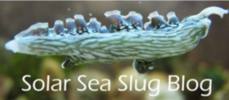Monthly Archives: December 2016


Mystery Alga
As I mentioned in the previous post, sometimes it is not so easy to identify an alga. In this case, it is a species that bloomed spectacularly when a local reefkeeper set up a new tank. The rock had been thoroughly cleaned and bleached, and no corals or fish had been added, so Alan did not expect the growth of nuisance algae. He was rather surprised to see a rapid, spectacular bloom of long, furry green algae.
At first we thought is might be Bryopsis (yay!), so it seemed worth trying to feed to the slugs. Once I saw and felt it, it was clearly something else. It was soft, like Derbesia, but longer and had branches that extended radially (like a bottle brush) from the main stem. Bryopsis feels coarser, and the branches extend in a single plane (like a fan). So, it was not one of the usual suspects. Nonetheless, it was worth throwing some into a tank to test whether the gals would eat it. They did not immediately plunge into it, as they would have for Bryopsis, but they seemed to find it palatable enough. Note the fine structure of the branches in the photos below.
The plant has some characteristics of the order Bryopsidales, such as the lack of clear cellularization. It looks like the plant is made up of a continuous, single cell.

Stalk, showing absence of cellular divisions. The little round bumps on the branches are reproductive structures. Scale bar = 1 mm. 12/27/16

Acrosiphonia spinescens from Algaebase, showing cellular divisions and hook-like branches. © Ignacio Bárbara
I thought a quick look at the DNA sequence would clear things up, but that was not the case. The closest match, Acrosiphonia, with 88% sequence identity. That’s not a very good match, and even though it looks somewhat like Acrosiphonia, the unidentified alga lacks several key features, such as the hooks on the branches (which cause mature plants to develop a dreadlocked appearance) and clear cellularization of Acrosiphonia. Plus, Acrosiphonia is a cold water species, unlikely to thrive in a warm reef aquarium.
The closest visual match so far is Trichosolen, which does have warm water species. The only species with rbcL sequence in the database (T. myura) is only an 86% match for DNA, so it’s probably not the one either.
By way of comparison, the usual pest algae (various species of Bryopsis and Derbesia) were only 82% – 83% identical, so we can at least rule out the possibility that it is an oddball species of one of those.
The hunt continues for a match. Not very satisfying, but some days are like that.


Observations on Algae
Happy Holidays to all of you fans of slugs!
Although the site and the project are devoted to adorable molluscs, we would be nowhere without algae. These days, I spend more time and resources trying to acquire, grow, and identify algae than I do attending to Elysia. It should not be a surprise, given the outsize role of algae in the biology of the slugs, but, until this project was underway, I had never given a lot of thought to the care and diversity of algae. Subsequent posts will describe some of the progress in algae care, but today we’ll focus on some systematics and molecular biology.
The plant in the photo above has been nagging at me for well over a year. I can’t remember exactly how it came up, but KP Aquatics mentioned that they had a species of algae they called “spongy sea pansy,” which was like Udotea, but larger and squishier. They were quite a bit taller than Udotea, grew in clumps, and were indeed quite spongy. Their biology is somewhat different from other algae in the order, in that the thallus (the body of the alga) dies back periodically, and a new one grows from the rhizoid (the rootlike part). In my experience, species like Udotea or Penicillus send out runners that produce new thalli, and the old ones just die off.
I have been referring to them as Avrainvillea, because they fit the description reasonably well, but had never done the hard work of verifying that it was not a similarly squishy genus, such as Rhipilia or Cladocephalus.
A real phycologist (algae specialist) would have probably started with a good microscope and species key. I took the molecular route, since I was already using PCR to amplify DNA from the rbcL gene in a few other species, and sending it off for sequencing.
Because I was testing new PCR machines, I had set up three independent reactions, and the results were the same. The screenshot below shows the results of a BLAST search for one of the sequences through the NCBI database, with the closest match at the top. The second best, with 98% of the nucleotides being identical, is Avrainvillea nigricans. The best match (99%) is to an “uncultured Ulvophyceae” clone from a study by Christa, Gould, Wagele, and their collaborators. If I read the entry correctly, the sequence is from kleptoplasts extracted from Costasiella, a Caribbean slug that feeds on…did you guess…Avrainvillea. To provide a little context, Cladocephalus and Rhipilia, the genera that were possible candidates based on appearance, were only 93% and 82% identical, respectively.
That is a pretty clear-cut result. It looks like Avrainvillea, it is squishy like Avrainvillea, and its DNA is essentially an exact match for Avrainvillea nigricans. It is Avrainvillea.
As you’ll see in the next post, the results aren’t always so easy to interpret.








Recent Comments